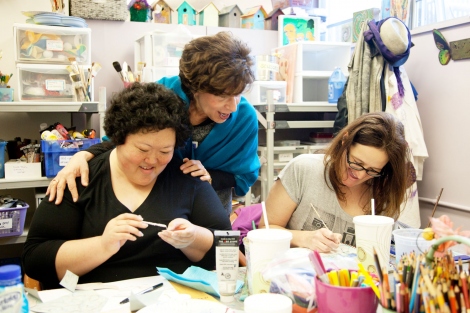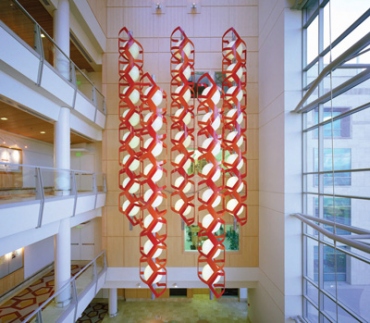
The idea of art as medicine dates back to antiquity, but recently the concept is drawing increasing interest from the medical and science communities.
Seated at a table dotted with paintbrushes, pencils and curios, Hideka Suzuki is creating an abstract on a small canvas. It’s not an idle craft project; for her, it’s a form of therapy.
“Sometimes I don’t even know what I’m thinking until I sit down and start drawing. Then my feelings come out on paper,” said Suzuki, a teacher in remission from uterine cancer.
She’s a participant at Art for Recovery, a pioneering program at the UCSF Helen Diller Family Comprehensive Cancer Center that has brought patients together since 1988 under the philosophy that creating art – no skills required – has a central role in healing.
It’s hard to empirically measure that impact because so many of art’s benefits are indirect, said Theresa Allison, MD, PhD, an associate professor in the UCSF Division of Geriatrics who has a background in musical anthropology. But, she said, therapies that benefit a patient’s emotional wellbeing can have real impact on overall health.

Art for Recovery director Cindy Perlis, center, works with Hideka Suzuki, left, and Sylvia Parisotta, right, as they get creative during a program gathering at UCSF's Mount Zion campus on Nov. 12. Photo by Cindy Chew
“We are finally at a tipping point, where the health sciences recognize the impact of loneliness and depression on health care outcomes, and we recognize the positive impact of visual and performing arts on symptoms management,” Allison said.
“Now we’re starting to ask why, and to bring in the science to study art’s impact. National funding agencies are starting to support this, and we’re going to see a lot of research emerge in upcoming years.”
Over the last few decades, a growing body of studies and anecdotal evidence suggesting that art is healing have driven the incorporation of art into medical settings. Nearly half of the health care institutions in the United States reported including arts in health care programming, ranging from art and music therapy to featuring visual art in hospitals.
“It’s a huge opportunity to think about using different modes of healing,” said Julene Johnson, PhD, a cognitive neuroscientist and professor at the UCSF Institute for Health & Aging. She’s running a study measuring the health impacts of singing in a choir. “The nice thing about the arts is our long, long history of using music and arts for healing across thousands of years, and the fact that it’s relatively low cost to implement.”
A History of Healing Influence
A landmark 1984 study published in Science found that patients recovering from gall bladder surgery recovered more quickly if they were in hospital rooms with a view of trees, as compared to a view of only a brick wall.
The patients were in the same suburban hospital with the same nurses in rooms that were close to identical, but those who could view nature required less potent painkillers and had shorter postoperative stays.

Art and Science Intertwined at UCSF
In 1999, as the Mission Bay campus took its first steps from vision to reality, then-Chancellor Mike Bishop pledged 1 percent of campus construction costs to establish initial funding for a public art program. The chancellor's pledge followed UCSF's longstanding commitment to enrich campus life by integrating a wide range of art into public space, reflecting the diversity of the community.
This set the stage for a flurry of other research on design variables in health care settings that posed the same question: Could healing be about more than good medicine and empathetic clinicians? Not every hospital room can offer patients a bucolic view, so researchers sought to find out if art depicting a pleasing scene might deliver the same positive effects.
Indeed, multiple studies have shown that a hospital’s physical environment is much more than a backdrop for health care delivery. The presence of nature scenes and art has a measurable impact on patients’ pain levels.
For example, for about 75 percent of burn victims, painkillers fail to alleviate their pain. In a small 1992 study in the Journal of Burn Care and Research, researchers experimented with using videos of “scenic beauty” as a distraction technique. Patients with severe burns reported lower pain intensity during dressing changes when shown the beautiful videos in addition to their medication.
Likewise, a 2003 study out of Johns Hopkins University found that nature scene murals displayed by the bedside reduced pain for patients undergoing bronchoscopy, a procedure in which a narrow tube with a scope is passed from the nose or mouth into the airways.
Hospitals across the country are increasingly acting on these findings.
At the UCSF Medical Center at Mission Bay, art plays a central role in the design of the new cancer, women’s and children’s hospitals. In addition to art sculptures, paintings and interactive pieces featured throughout the complex, patient rooms include views of rooftop gardens or the San Francisco Bay, and scan rooms are equipped with screens displaying calming nature scenes.
“We wanted art to be integrated into the fabric of our new facilities in a way that reinforced the healing environment that we were creating,” said Cindy Lima, executive director of UCSF Mission Bay Hospitals Project.